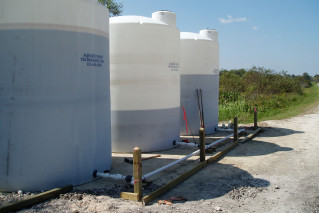Hybrid Wetland Treatment Systems are uniquely effective and efficient, with various advantages over conventional treatment systems.
Disadvantages of Traditional Systems

High Chemical usage
Traditional chemical treatment of stormwater can provide very reliable phosphorus reduction with high chemical usage.

High Land and Capital Costs
Traditional wetland treatment provides for highly variable phosphorus and nitrogen removal at low operating costs but with a high land and capital cost. Removal efficiencies also suffer significantly in regions that experience seasonal dry conditions (for example, the Lake Okeechobee Watershed).
Benefits of HWTT Systems
- Relative to conventional systems, HWTT facilities enabled a 39% to 67% reduction in chemical use in full-scale comparative trials.
- Provide the effectiveness and reliability of chemical treatment systems for phosphorus removal (up to 96%), while minimizing chemical use.
- Demonstrate cost effective phosphorus and nitrogen removal.
- Consistent attainment of low nutrient discharges that can meet the federal and sate regulatory requirements.
- No by-product disposal.
- A configuration that is highly adaptable for the treatment of agricultural and urban streams, lakes, reservoirs and ponds.
- Significant reduction in required land foot-print.
- Minimal infrastructure requirements.
- Assist in achieving restoration goals.
- Provide environmental benefits via wetland and wildlife habitat restoration and creation.
- Utilize appropriate sequences and configurations of wetland unit processes to transform/remove additional contaminants and pathogens.
- No adverse treatment impacts during prolonged periods of reduced flow or drought.
- No lag in treatment performance upon initiation of pulsed flows.
